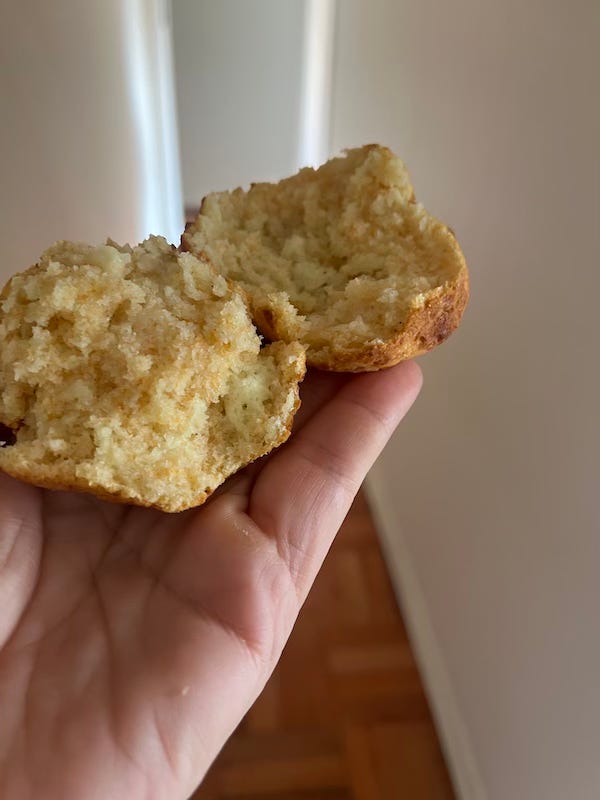Dreaming of foods past
Or: how I made something like something I had for breakfast in Colombia (almojábanas) out of what I had on hand
I wish I could go back and taste everything I’ve ever eaten with that old stomach, that old system, that old ability to eat antroewa, an eggplant so bitter that I could taste it in my back molars, and spear tiny shrimp out of a fermented Tacacá soup that made my mouth go numb due to the jambu (an herb) it contains, in Paramaribo, Suriname and Manaus, Brazil, respectively. To the best of my recollection, neither of these foods did anything to me besides surprise my palate and in one case, my teeth.
But that was the me of then, and not the me of now. I am somewhere between 82 and 91 percent ok with that at the present moment. I still lament the extra stress it brings me to think about traveling (though this I have done), and the many tiny bags of nuts and me-safe granola bars that I will find forever more in any bag or pocket I stick my hand into.
But we’re not here for that. Instead, I want to talk about a win.
When I was in Colombia one time, with a friend, it was a rainy drippy day in Zipaquirá, where there is a giant salt mine, parts of which have been carved into a cathedral and there’s also a movie theater inside, and if you happen to be in the area, it’s a really unusual attraction. We had watched the movie and marveled at the sights, and went outside into the beautiful colonial town for a snack and some coffee. It might have been breakfast, I don’t recall. At any rate, it was breakfast-adjacent.
Colombian pastries are mildly sweet, some of them are fried, or have roasted corn flour in them (like that used to make arepas, people in North America can substitute corn meal, in Chile you can also use chuchoca). They all looked tasty, but I didn’t know what I was looking at. I pointed at one at random and asked what it was, and what it was like.
These are typical of this area, the woman told me, pointing to the almojábanas. “They’re mildly sweet, and have cheese in them.” So what I expected was a mildly sweet dough with some cheese in the middle.
Instead I got something wholly different. It was chewier, sweeter, had more tensile strength than I was expecting. It was so pleasant, so not dry, paired so well with my Colombian coffee. I asked more about it, and learned that the mild cheese was actually mixed into the dough, as a wet ingredient.
I have often thought about the foods I have eaten in different parts of the world and whether or not they translate to my current reality, in terms of ingredient availability, or current tolerance. I’m also well aware of the current US trend to cottage cheesify or Greek yogurtify all possible foods. We don’t get good cottage cheese here and the last time I tried it in the states it ended badly. Greek yogurt is not welcome in my kitchen (no yogurt, in any form has worked for me since figuring out that I have histamine intolerance, whether kefir, yogurt, skyr, or Greek yogurt, industrial or homemade), and so sadly, I must soldier on with neither cottage cheese nor yogurt at every meal. I know, it’s tragic.
Part of this dairyfying movement is part of the whole EAT ALL THE PROTEIN movement, which I neither avow nor disavow, but I do scratch my head on how we have not learned that so many miracle nutrition solutions are just a trend, looking at you Snackwell’s cookies, and also that every body is different. But I digress.
The stars aligned and as I mused over the cheese-as-part-of bread recipes (hello? Eastern Europe? come get your bagels), I remembered the almojábanas, did a little research and though we don’t get the right kind of cheese here, we do get something called queso fresco, which I think of as kind of farmer’s cheese adjacent, or maybe solid cottage cheese (this is in Chile, I am not talking about Mexican queso fresco). So I looked up a recipe and whipped up these fun pliable little breadlets, or rolls, you might say, and I ate them fresh, with coffee and toasted beside soup and I’m going to say you know what? I would make them again. They were even gluten free, (by tradition) which suits me most days.
Lesson #1 all is not lost
Lesson #2 eating food from different cultures will always interest me
Lesson #3 much of the time you can probably improvise the ingredients and it will come out fine
Lesson #4 I am not in charge of how much protein you eat
I based my recipe on this one, halved it but did not halve the egg, only used 150 grams of our available cheese and I have no idea how much milk I added. I am not going to write up the recipe because you probably don’t get our cheese, but it’s a good starting point (you can obviously read it in the language of your choice through the magic of AI. Also Colombians, do not hate me, I meant well and used the ingredients that were easily available. I will use the following adjective to describe these as I call all of my cultural food modifications, as being “almojábana-adjacent.”
I hope you make something delicious or nostalgic or nostalgic-adjacent today.




